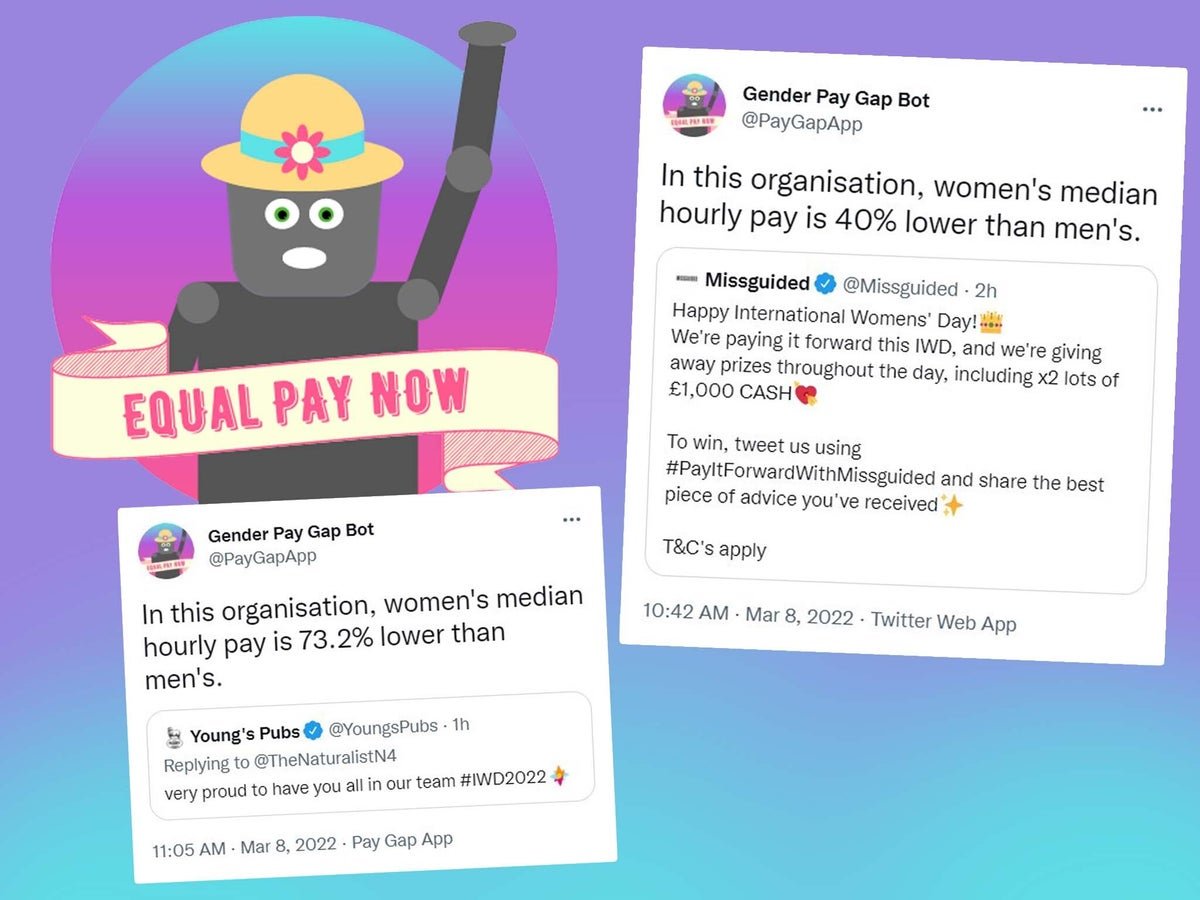- How did a Twitter bot reveal the underlying lack of humanity in so many leading brands this International Women’s Day?
- How can we all avoid being Missguided in our marketing?
- And how did Adidas ‘mind the gap’ when it came to jumping on the “brandwagon”?
This is Zonal Marketing – a series which explores how innovative brands are shaking up their industries with extraordinary marketing.
In this episode I’m exploring how the Gender Pay Gap Twitter bot managed to troll Barclays Bank, Missguided and many more over their International Women’s Day posts this week.
I’ll also examine how adidas escaped the criticism despite ostensibly following the same playbook.
And, finally, I’ll see what lessons we can take from these examples that you can apply to your company to ensure you’re never accused of such ‘virtue signalling’.
SOMEWHAT MISSGUIDED
International Women’s Day 2022 saw the usual slew of posts from brands proclaiming their support for women. Many of them focussed on female members of staff that are showing courage and leadership in their given field. A few heroed their female customers. Some companies even went as far as to create initiatives to support women in their chosen industry. So far, so virtuous.
But then the Gender Pay Gap Bot reared its mechanical head and after ‘computer said no’ many brands started malfunctioning all over the place.
Created by Francesca Lawson and Ali Fensome – a freelance social media manager and software developer respectively – the bot searches for companies tweeting using a variety of related hashtags and terms, automatically looks up their figures on the UK government Gender Pay Gap database and then issues a tweet revealing that company’s discrepancy between the median amount paid to women vs men.
Needless to say, some companies did not fare very well! Among the most high profile victims were Barclays Bank (which pays its women 35% less than its men) and – believe it or not – women’s online clothing retailer, Missguided, which pays its women a whopping 40% less. The worst case examples had a 70-plus percentage difference.
And this is not the first time brands have been called out for issuing meaningless platitudes around these sorts of events. In 2017, car manufacturer Audi put out a TV ad called “Daughter”, which championed gender equality, only to have it revealed that the company has no women on its six-person executive team. Its supervisory board is only 16% women – well below the already-low average of 20% for female representation on corporate boards of Fortune 500 firms.
But sometimes the brand in question’s lack of sincerity isn’t so obvious. Sometimes it just doesn’t feel right that brand X is commenting on subject Y. Men’s shaving brand Gillette was heavily criticised for its ‘We Believe’ commercial that addressed toxic masculinity and sexual harassment around the time that the #MeToo movement was at its height.
In his book, Hook Point, Brendan J Kane says; “Although the message in the ad is great – of course men and women should treat others with respect – it also makes sense that audiences have been put off. As a brand,” he continues, “Gillette had not talked about social responsibility prior to this campaign; they’d always focussed on hair removal! Which is why, when they suddenly came out with an ad telling men they need to behave differently, many consumers felt that they were trying to insert themselves in a conversation they had no permission entering. Because that’s not who they are as a company. To some in the audience,” Kane concludes, “the ad came across as gratuitous and opportunistic.”
In summary, it’s not enough to just live your brand values, you have to be seen to be living them. Consistently, considerately and compellingly. No one doubts that people at Procter and Gamble – Gillette’s owners – believe that women shouldn’t be treated as equals. But to suddenly come out with an ad, criticising so-called masculine behaviour when they’ve been so entrenched in upholding the traditional values of what it means to be a man just made the ad feel tone deaf. They had no right to be commenting in the space. And in the next section, I’ll discuss how another company – also in the clothing space – avoided a similar pitfall.
IT’S NOT IMPOSSIBLE
Not every campaign that came out this year struck the wrong note. Sports apparel company, adidas put out their “I’m Possible” campaign which encouraged women in the United Arab Emirates to post an image of themselves working or playing sport for the chance to feature on a digital billboard in Dubai.
Adidas isn’t a “women’s” brand. It doesn’t sell exclusively to women like Missguided does. Nor does it exclusively sell products which appeal to women like Always – another P&G brand who achieved critical acclaim for their fantastic “Like A Girl” campaign in 2014.
So why didn’t adidas suffer the slings and arrows of public critique? Well, first of all, the ad features several high-profile female athletes from the Middle East, all of whom are pre-existing brand ambassadors. Such historic, and long-term commitments are a good indication of the brand’s commitment to supporting women in sport.
But secondly, the company has a track record of championing the cause of women’s rights in their marketing. As far back as 2005, the company was partnering with Stella McCartney and simultaneously placing print ads that showed women how they show men; driven, powerful and alone, rather than sexualised, or portrayed as doing sport for ‘fun’ or ‘friendship’. In recent times they’ve run their ‘Now is Her Time’ and ‘Reimagine Sport’ ads.
But perhaps most tellingly of all, the company has done the work on its brand purpose. They’ve identified four core pillars, one of which is called ‘She Breaks Barriers’ – aimed at getting girls to join and stay in sport. This shows that they’ve identified that women’s rights are central to the very essence of the brand and ensures that their commitment to the cause will go well beyond an International Women’s Day post. And they’re happy to be held to it. They publish the entire brand purpose policy online.
What this means is that when Adidas say they stand for gender equality, we believe them. We feel in our gut that it’s genuine. We don’t question it or call them out. It just feels right. And when it feels right, it drives brand loyalty amongst consumers, encourages advocacy and increases the brand’s value… not that that’s why they’re doing it, of course!
Oh, and for those of you that are wondering what their Gender Pay Gap is, it’s 8%. Not beyond reproach but certainly not the worst example.
MIND THE GAP
So how do we apply these lessons to the work we do on our own companies? First of all, a good way to ensure you aren’t caught out by this sort of thing is simply to pay staff who are doing the same job equally, hire equally and promote equally – regardless of gender, race, and sexual orientation. This shouldn’t need to be said, of course, but clearly it does bare repeating.
But looking at this purely from a marketing perspective, a large part of the issue when companies jump on these “brandwagons” is that it feels disingenuous. So build it in to your core values at the outset. Work out why you do what you do and what purpose it’s there to serve. What issue are you looking to solve? And for whom? Once you’ve identified these core characteristics, write them down. Put them in stone. Put them front and centre on your website, in your office and make them a part of every job interview you conduct with potential employees.
Create a tone of voice and visual identity around them. Make sure that, with every word of copy, every image, every video, every song you put in your ad or on your hold music… with absolutely every interaction your customer has with your company, you’ve asked yourself does this choice adhere to our brand values?
To find out more on this, try my episode on ‘How Not To Be Boring’.
But secondly, it’s about then identifying your opportunities. What are the plannable and unplannable events that you expect to take place over the coming year, and for which ones does your company have a place in conversation? If one of your brand values is equality, and you’ve demonstrably shown that in your business practises and marketing to this point, then you have the right to speak on International Women’s Day. If not, leave well alone.
It doesn’t mean you don’t believe in these things. It just means you’re not contributing to the noise around the topic, and letting those who really are breaking new ground in the space be seen and heard properly.
Select a handful of things that definitely will happen (International Women’s Day, the Super Bowl, the Oscars for example) that – based on your core values – you know your customer cares about, and that you have a point of view on.
And also try to identify a type of situation that might occur that your company would have a voice in. #MeToo and Black Lives Matter would be examples. But so would something simple like a cultural event such as a particularly popular song, film, fashion trend or meme blowing up.
With all of the above, think about what the core message will be that you will be aiming to convey, how you will put it out in a creative and compelling way, which channels it will go on and where it will be targeted.
To find out more on how to do all of this, try my episode on ‘How to Pick Your Moments’.





